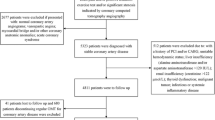Abstract
Aim of the study
In contrast to the general population, individuals with primarily persistent elevation of inflammatory activity display a significant association between inflammatory biomarkers and atherosclerotic burden. In older individuals, immunosenescence upregulates the innate response and, by this way, may hypothetically favor the presence of this association. The aim of this study was to evaluate this hypothesis in healthy octogenarians.
Methods
Participants (n = 208) aged 80 years or older, asymptomatic and without medical and laboratory evidence of chronic diseases or use of anti-inflammatory treatments were included in the study. Lipid profile and plasma C-reactive protein (CRP) were measured at baseline and cardiac computed tomography was performed within 1-week interval for measuring coronary calcium score (CCS).
Results
The median plasma CRP was 1.9 mg/L (1.0–3.4) and 33 % of the participants had elevated CRP defined as ≥3 mg/L. Among those with high CRP, there was an increased frequency of high CCS (≥100) as compared with their counterparts (71 vs 50 %, p = 0.001). The association between CRP and CCS persisted even after adjustment for age, sex, cardiovascular risk factors and statin therapy. The area under the receiver-operating curve for CRP was 0.606 using CCS ≥100 as a binary outcome. The sensitivities for CCS ≥100 were 40 and 74 % for the cutoff points of CRP ≥3 or 1 mg/L, respectively.
Conclusion
The present study was able to confirm that in very elderly individuals, systemic inflammatory activity is independently associated with coronary atherosclerosis burden.
Similar content being viewed by others
References:
Morrow DA, Rifai N, Antman EM, Weiner DL, McCabe CH, Cannon CP, Braunwald E (1998) C-reactive protein is a potent predictor of mortality independently of and in combination with troponin T in acute coronary syndromes: a TIMI 11A substudy. Thrombolysis in myocardial infarction. J Am Coll Cardiol 31(7):1460–1465
Sposito AC, Alvarenga BF, Alexandre AS, Araujo AL, Santos SN, Andrade JM, Ramires JA, Quinaglia ESJC, Coelho OR (2011) Most of the patients presenting myocardial infarction would not be eligible for intensive lipid-lowering based on clinical algorithms or plasma C-reactive protein. Atherosclerosis 214(1):148–150. doi:10.1016/j.atherosclerosis.2010.10.034
Gupta NK, de Lemos JA, Ayers CR, Abdullah SM, McGuire DK, Khera A (2012) The relationship between C-reactive protein and atherosclerosis differs on the basis of body mass index: the Dallas Heart Study. J Am Coll Cardiol 60(13):1148–1155. doi:10.1016/j.jacc.2012.04.050
Hamirani YS, Pandey S, Rivera JJ, Ndumele C, Budoff MJ, Blumenthal RS, Nasir K (2008) Markers of inflammation and coronary artery calcification: a systematic review. Atherosclerosis 201(1):1–7. doi:10.1016/j.atherosclerosis.2008.04.045
Yiu KH, Wang S, Mok MY, Ooi GC, Khong PL, Mak KF, Lam KF, Lau CS, Tse HF (2009) Pattern of arterial calcification in patients with systemic lupus erythematosus. J Rheumatol 36(10):2212–2217. doi:10.3899/jrheum.090312
Wolf J, Weinberger B, Arnold CR, Maier AB, Westendorp RG, Grubeck-Loebenstein B (2012) The effect of chronological age on the inflammatory response of human fibroblasts. Exp Gerontol 47(9):749–753. doi:10.1016/j.exger.2012.07.001
Freitas WM, Quaglia LA, Santos SN, Soares AA, Japiassu AV, Boaventura V, dos Santos Barros E, Cordova C, Nobrega OT, Sposito AC (2011) Association of systemic inflammatory activity with coronary and carotid atherosclerosis in the very elderly. Atherosclerosis 216(1):212–216. doi:10.1016/j.atherosclerosis.2011.01.040
Smith RA, Cokkinides V (2006) Eyre HJ (2006) American cancer society guidelines for the early detection of cancer. CA Cancer J clin 56(1):11–25 (quiz 49–50)
World Health Organization (2007) A guide for population-based approaches to increasing levels of physical activity: implementation of the WHO global strategy on diet, physical activity and health
Schuett H, Luchtefeld M, Grothusen C, Grote K, Schieffer B (2009) How much is too much? Interleukin-6 and its signalling in atherosclerosis. Thromb Haemost 102(2):215–222. doi:10.1160/TH09-05-0297
Tintut Y, Patel J, Parhami F, Demer LL (2000) Tumor necrosis factor-alpha promotes in vitro calcification of vascular cells via the cAMP pathway. Circulation 102(21):2636–2642
DeGoma EM, French B, Dunbar RL, Allison MA, Mohler ER 3rd, Budoff MJ (2012) Intraindividual variability of C-reactive protein: the multi-ethnic study of atherosclerosis. Atherosclerosis 224(1):274–279. doi:10.1016/j.atherosclerosis.2012.07.017
Demer LL, Tintut Y (2008) Vascular calcification: pathobiology of a multifaceted disease. Circulation 117(22):2938–2948. doi:10.1161/CIRCULATIONAHA.107.743161
Acknowledgments
Prof. Sposito and Nadruz are supported by a fellowship grant of productivity in research from the Brazilian National Research Council (CNPq).
Conflict of interest
The authors do not have any conflict of interest related to the present study.
Author information
Authors and Affiliations
Corresponding author
Additional information
On behalf of The Brazilian Study on Healthy Aging.
Rights and permissions
About this article
Cite this article
Quaglia, L.A., Freitas, W.M., Soares, A.A. et al. C-reactive protein is independently associated with coronary atherosclerosis burden among octogenarians. Aging Clin Exp Res 26, 19–23 (2014). https://doi.org/10.1007/s40520-013-0114-x
Received:
Accepted:
Published:
Issue Date:
DOI: https://doi.org/10.1007/s40520-013-0114-x




